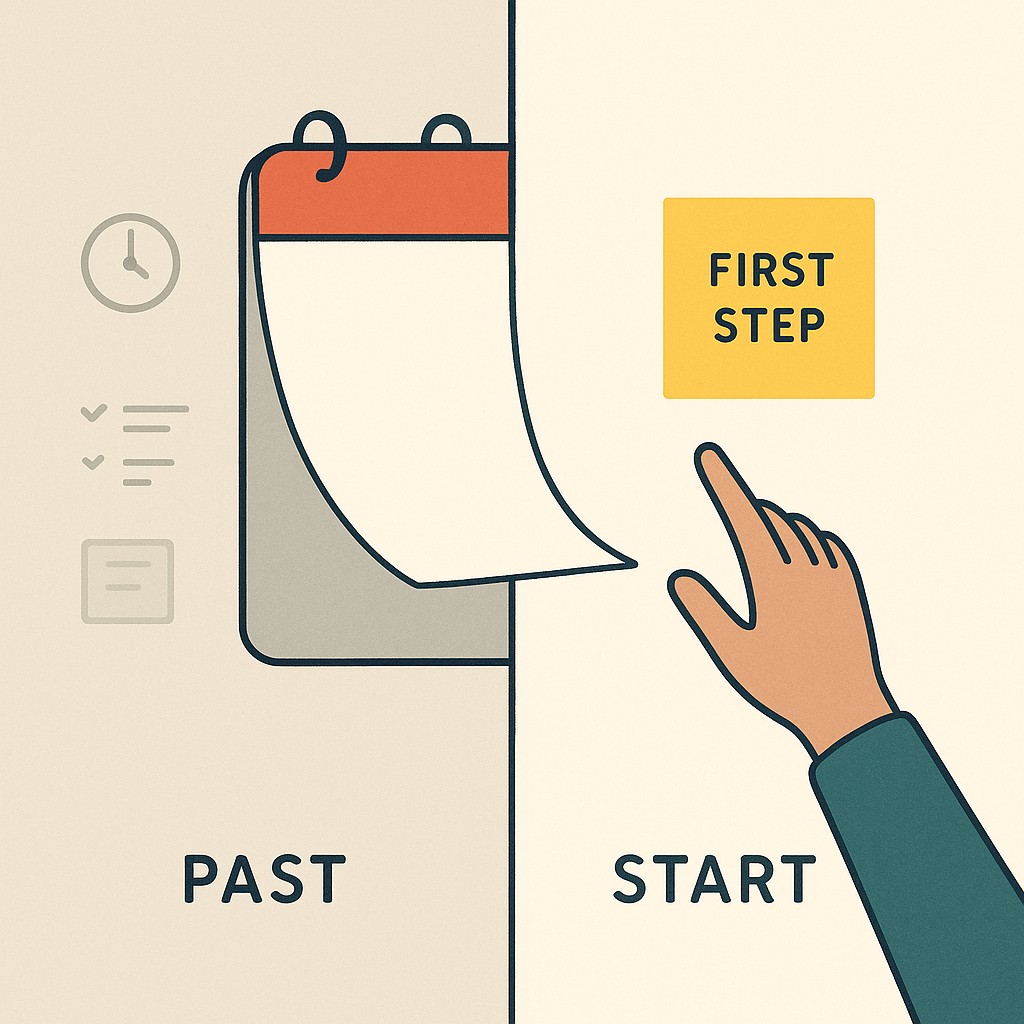Apply the Fresh Start Effect to Build Real Momentum
Apply the Fresh Start Effect to Build Real Momentum

The Hidden Power of a Fresh Start: Apply the Fresh Start Effect
The end of the year has a way of hitting pause on life, at least for a minute, before everything spins up again. It’s almost comical. Every headline and motivational email shouts about resolutions, urging us to resolve, strive, overhaul. Nearly 70% of Americans skip making New Year’s resolutions, simply because they don’t like them. I used to roll my eyes at the hype. But the truth is, when the new year hit, I felt a little jolt anyway.
Instead of changing my whole life, I picked one thing—a goal that had been floating around the back of my mind for months—and did one small thing about it. Just one. Not a dramatic transformation. More like a nudge. That tiny action showed me how to apply the fresh start effect to build momentum faster than any perfect plan. It started just because the calendar changed.
Are you one of the millions who toss the whole New Year’s thing out the window? Or maybe you never even bother opening it.
I’ve said it before, you don’t need to wait for a specific date to chase your goals. Seriously, you don’t. But if you’re anything like me—or the dozens I’ve coached—it’s still tough to stick with change when it’s just another random Tuesday. When you tap motivation from temporal landmarks—whether it’s using New Year as a reset, a new sprint, or even just a Monday—change gets easier. They give you a line in the sand. A before, and an after.
That’s the magic of a fresh start, a powerful temporal landmark. A chance to reflect, refocus, and take action. Not with grand gestures, but with one new step you let actually matter.
Let’s get real about what usually happens. For engineers and AI folks especially, embracing a fresh start helps prevent important goals from getting stuck in limbo. We let them stall out. So let’s name that trap and do something different, right now.
Why Important Goals Get Stuck—and How to Unstick Them
It’s easy to let goals live in the “if only” category. If only I had more time. If only the codebase was cleaner. If only there wasn’t a feature crunch. I hear this constant refrain from colleagues and clients, and honestly, I’ve said it to myself more times than I can count. These are the goals we care about—shipping that tool, finally cleaning up a module, learning a new library—but they stay in the shadows, waiting for perfect conditions that never come. Another year slips by, backlog gets bigger, nothing gets crossed off.
If only I had more time. That’s the classic. Every January I catch myself thinking, “This quarter will be different… once the client work eases up.” Weeks pass. I realize I’m still saying it. Time never clears up by itself. It just rotates to the next excuse.
To overcome analysis paralysis, notice how perfectionism shows up in sneaky ways for engineers and ML folks. We scope projects way bigger than they need to be, planning for every edge case up front, worrying the first version will be too rough to share. I see people circle around docs, stress about which framework to use, and never actually start. The paralysis usually gets masked as “thinking it through” or “waiting for the right moment”—when instead you should stop analysis paralysis and act.
Here’s what I’ve learned the hard way, and through coaching others. Progress doesn’t require perfect conditions. Shipping is possible even when things are messy. Momentum comes from taking a small, intentional step, not from finding the mythical perfect window. When you make a move, however minor, you reduce risk and start carving out a path forward. That single action sets off a feedback loop: it shrinks the “if only” pile, builds confidence, and accelerates meaningful work. Most of my own breakthroughs came not when all the stars aligned, but when I chose to act anyway.
So before this fresh start fades, pick one deferred goal that’s been sitting in your backlog. Name it. Maybe it’s shipping a tool, refactoring a stubborn module, or finally digging into a training library. That goal—let’s use it in the next section to get you out of limbo and into action.
The Practical Playbook: Start with One Small Step
Here’s the playbook, stripped down so you’ll actually use it. Take advantage of the moment, pick one goal you care about, and start with one small move. You don’t need a spreadsheet, a manifesto, or a kanban board to get going. All you really need is an anchor, a focus, and an action—today.

Start with the moment. To apply the fresh start effect, tie your effort to temporal landmarks—like New Year’s, the first sprint of the quarter, or just the beginning of this week—that work like psychological resets. Tie your commitment to a date or event. It sounds too simple, but the spike in motivation to hit the gym right after a birthday can match the effect of adding open hours. Temporal landmarks really do give us a reset. Mark the day as the start. Decide: “This week, I fix the flaky test.” Or “Next sprint, I ship the internal dashboard.” Give yourself a start line. Don’t wait for some undefined better time.
A quick tangent. After last New Year’s, I swapped out a grinding laptop fan. Not a glamorous accomplishment, but for some reason that tiny fix made me clean up three old scripts I’d been ignoring for months. The little win unlocked a bigger move, and honestly, I doubt it would’ve happened if I’d waited for a “better” moment. Sometimes, one random technical reset sets off a chain of actual momentum before you notice it.
After marking your moment, choose one tangible goal. No vague ambitions. Pick something specific—ship the internal tool, refactor the flaky test suite, train a baseline model, or just read one page of a tough paper every day. The trick is picking only one. Give it a name so your first action is obvious. The clearer your goal, the less avoidance room.
Now for the bit most people skip. Start with small steps today, and make the first one repeatable. Schedule a single, bite-sized action, tied to your landmark—a first commit before noon, a Monday standup update, “by end of week, change one function.” Do it now. Not tomorrow. If-then commitments work—a meta-analysis across 642 tests found they helped people improve thinking, moods, and behaviors. When you link action to a marker, you create a launchpad. Start small, but start now. Momentum actually grows faster than motivation ever did.
It’s not about perfection. It’s about picking your spot, choosing your target, and building velocity as you stack small daily wins. If you think back to those goals stuck in limbo I mentioned earlier, often the only thing missing was a moment and a move.
Staying on Track When Motivation Fades
I hear this worry all the time. “Isn’t logging just one commit, opening one small issue, or reading a single abstract basically pointless?” No. Not pointless. Those tiny actions stack up, each nudging the next, until confidence sneaks in. I’ve seen it in my own backlog. The missed opportunity is never the trivial step—it’s skipping it and waiting for something huge that never arrives. The path forward is always built on small stones.
You might be thinking, “I don’t have the time. Five minutes won’t make a difference.” But it’s enough to move the needle. Especially on days like today, when the fresh start energy is real. In five minutes, you could log a commit or scan an abstract. That small investment is the best way to start. Do it now, not later.
Worried you won’t keep going once conditions change? Tie your action to a recurring landmark, like the new sprint, Monday check-in, or even your first commit of the day—so you can reset after a missed day without losing momentum. Habits linked to a routine or set time make it easier to keep going—even as the context changes. In my experience, this shift turns “I’ll get to it” into “it just happens.” Even when things get busy or unpredictable.
Now, here’s the part I urge you to try. Pick one mechanism, test it this week, and just pay attention to what shifts. You’ll see the backlog shrink and your own confidence inch upward. If it doesn’t stick at first, tweak it—iterate like you would any technical problem. I’ll admit, I sometimes still get hung up on the perfect tracking system. I haven’t figured out how to stop chasing better tools instead of just working with the one I’ve already got. But I keep going. Progress, not perfection, wins every time.
Your Move: Start, Share, Build Momentum
Take five minutes—right now while the energy’s fresh—and write down one goal you’ve been putting off. Anchor it to your next temporal landmark—New Year, a new sprint, even just Monday. Commit to a single, repeatable step you can start this week. No “one day.” Put it on your calendar.
Want to boost your odds? Share your goal and first step publicly, or with your team, and use the fresh start effect to build collective momentum. You can use a simple hashtag like #YourMove, #FreshStartEffect, #SmallStepsBigImpact, or #NewYearGoals. It’s a way to link up with others who want that same momentum—and it helps you follow through.
If your fresh start includes sharing progress, use our AI content app to draft a README, sprint update, or launch note in minutes, so you can act now and keep momentum.
What I keep coming back to is this. Motivation spikes when we hit landmarks, but momentum only comes from action. Not from perfect plans. So anchor your intention to this New Year, this week, or your next sprint. Move now. Don’t wait for the right conditions. Start, commit, and let progress build—little by little, the way it always does.
Enjoyed this post? For more insights on engineering leadership, mindful productivity, and navigating the modern workday, follow me on LinkedIn to stay inspired and join the conversation.
You can also view and comment on the original post here .
